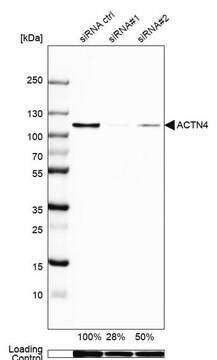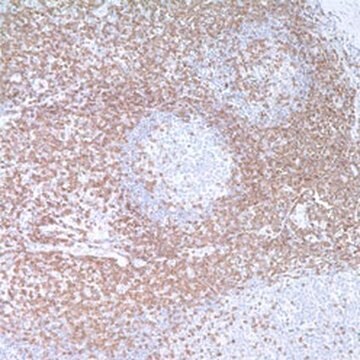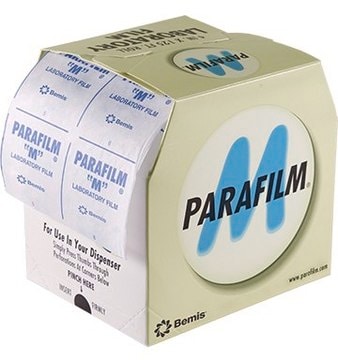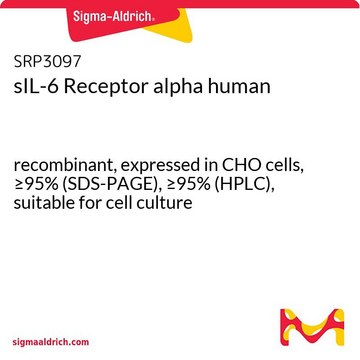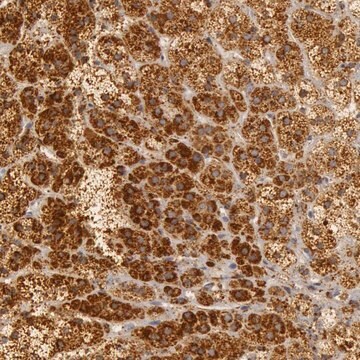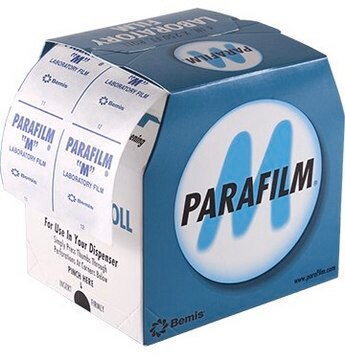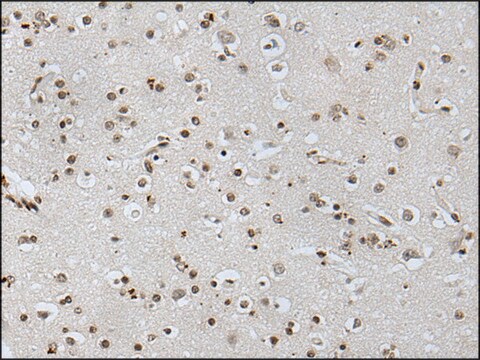推薦產品
生物源
rat
品質等級
抗體表格
purified immunoglobulin
抗體產品種類
primary antibodies
無性繁殖
MECA-79, monoclonal
物種活性
human, mouse
技術
flow cytometry: suitable
immunohistochemistry: suitable (paraffin)
immunoprecipitation (IP): suitable
western blot: suitable
同型
IgMκ
運輸包裝
ambient
目標翻譯後修改
unmodified
一般說明
Peripheral lymph node addressin (PNAd) is a mixture of glycoproteins that is expressed on high endothelial venules (HEV) and is required for lymphocyte homing. It is shown to be a ligand for CD62L (L-selectin) that is expressed on the surface of naïve and central memory T cells. PNAd is a sulfated and fucosylated glycoprotein recognized by the prototypic monoclonal antibody, MECA-79. Naïve T cells use PNAd to traffic into lymphoid organs in non-mucosal tissue sites. The interaction of PNAd with CD62L receptor is involved in tethering and rolling of lymphocytes along HEV in lymphoid tissues. Regulated appearance of PNAd+ HEVs is found during ontogeny of lymphoid tissues as well as in chronic inflammatory conditions. PNAd+ HEVs are reported to appear 24-48 h after birth in mouse peripheral lymph nodes and persist throughout life to support recirculation of lymphocytes. In humans PNAd+ HEVs are detected in fetal peripheral lymph nodes. PNAd+ HEVs are also shown to be present in several chronic inflammatory conditions, including thyroiditis, ulcerative colitis, psoriasis, rheumatoid synovitis, and cutaneous lymphomas. In murine models of inflammation, PNAd+ HEV-like vessels develop and these vessels are found to support lymphocyte recruitment. Studies on cancer in murine models and in humans have identified PNAd as a biomarker of improved disease prognosis and blockade of PNAd or its ligand, L-selectin, is shown to abrogate protective antitumor immunity in murine models. (Ref.: Sinha, RK et al. (2006). Vet. Immunol. Immunopathol. 110 (1-2): 97-108).
特異性
Clone MECA-79 detects Peripheral Node Addressin (PNAd) in human and mouse.
免疫原
Collagenase-dispersed lymph node stromal cells from BALB/c mice.
應用
Immunohistochemistry Analysis: A 1:50 dilution from a representative lot detected Peripheral Node Addressin (PNAd) in human liver and human pancreas tissues.
Western Blotting Analysis: A representative lot detected Peripheral Node Addressin (PNAd) in Western Blotting applications (Hemmerich, S., et. al. (1994). J Exp Med. 180(6):2219-26).
Inhibition Analysis: A representative lot detected Peripheral Node Addressin (PNAd) in Inhibition applications (Streeter, P.R., et. al. (1988). J Cell Biol. 107(5):1853-62;Michie, S.A., et. al. (1993). Am. J. Pathol. 143(6):1688-98; Berg, E.L., et. al. (1991). J Cell Biol. 114(2):343-9).
Immunoprecipitation Analysis: A representative lot detected Peripheral Node Addressin (PNAd) in Immunoprecipitation applications (Berg, E.L., et. al. (1991). J Cell Biol. 114(2):343-9).
Immunohistochemistry Analysis: A representative lot detected Peripheral Node Addressin (PNAd) in Immunohistochemistry applications (Sinha, R.K., et. al. (2006). Immunology. 119(4):461-9; Streeter, P.R., et. al. (1988). J Cell Biol. 107(5):1853-62; Michie, S.A., et. al. (1993). Am J Pathol. 143(6):1688-98).
Flow Cytometry Analysis: A representative lot detected Peripheral Node Addressin (PNAd) in Flow Cytometry applications (Sinha, R.K., et. al. (2006). Immunology. 119(4):461-9).
Western Blotting Analysis: A representative lot detected Peripheral Node Addressin (PNAd) in Western Blotting applications (Hemmerich, S., et. al. (1994). J Exp Med. 180(6):2219-26).
Inhibition Analysis: A representative lot detected Peripheral Node Addressin (PNAd) in Inhibition applications (Streeter, P.R., et. al. (1988). J Cell Biol. 107(5):1853-62;Michie, S.A., et. al. (1993). Am. J. Pathol. 143(6):1688-98; Berg, E.L., et. al. (1991). J Cell Biol. 114(2):343-9).
Immunoprecipitation Analysis: A representative lot detected Peripheral Node Addressin (PNAd) in Immunoprecipitation applications (Berg, E.L., et. al. (1991). J Cell Biol. 114(2):343-9).
Immunohistochemistry Analysis: A representative lot detected Peripheral Node Addressin (PNAd) in Immunohistochemistry applications (Sinha, R.K., et. al. (2006). Immunology. 119(4):461-9; Streeter, P.R., et. al. (1988). J Cell Biol. 107(5):1853-62; Michie, S.A., et. al. (1993). Am J Pathol. 143(6):1688-98).
Flow Cytometry Analysis: A representative lot detected Peripheral Node Addressin (PNAd) in Flow Cytometry applications (Sinha, R.K., et. al. (2006). Immunology. 119(4):461-9).
Research Category
Inflammation & Immunology
Inflammation & Immunology
This rat monoclonal Anti-Peripheral Node Addressin (PNAd) Antibody, clone MECA-79, Cat. No. MABF2050, is tested in Flow Cytometry, Immunohistochemistry (Paraffin), , Immunoprecipitation, Inhibition, and Western Blotting for the detection of Peripheral node addressin.
品質
Evaluated by Immunohistochemistry in human tonsil tissue.
Immunohistochemistry Analysis: A 1:50 dilution of this antibody detected Peripheral Node Addressin (PNAd) in human tonsil tissue.
Immunohistochemistry Analysis: A 1:50 dilution of this antibody detected Peripheral Node Addressin (PNAd) in human tonsil tissue.
標靶描述
50-250 kDa calculated.
外觀
Format: Purified
Purified rat monoclonal antibody IgM in PBS with 0.05% sodium azide.
儲存和穩定性
Stable for 1 year at 2-8°C from date of receipt.
其他說明
Concentration: Please refer to lot specific datasheet.
免責聲明
Unless otherwise stated in our catalog or other company documentation accompanying the product(s), our products are intended for research use only and are not to be used for any other purpose, which includes but is not limited to, unauthorized commercial uses, in vitro diagnostic uses, ex vivo or in vivo therapeutic uses or any type of consumption or application to humans or animals.
未找到適合的產品?
試用我們的產品選擇工具.
儲存類別代碼
12 - Non Combustible Liquids
水污染物質分類(WGK)
WGK 1
分析證明 (COA)
輸入產品批次/批號來搜索 分析證明 (COA)。在產品’s標籤上找到批次和批號,寫有 ‘Lot’或‘Batch’.。
我們的科學家團隊在所有研究領域都有豐富的經驗,包括生命科學、材料科學、化學合成、色譜、分析等.
聯絡技術服務